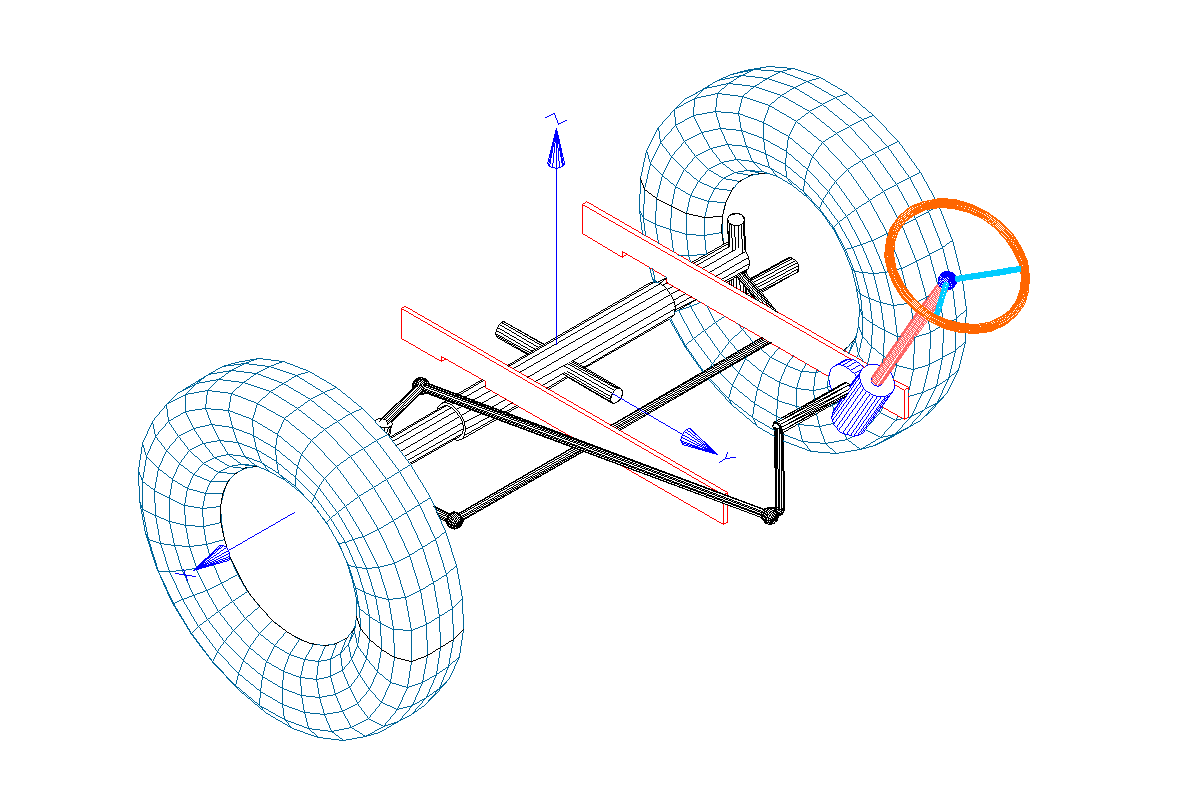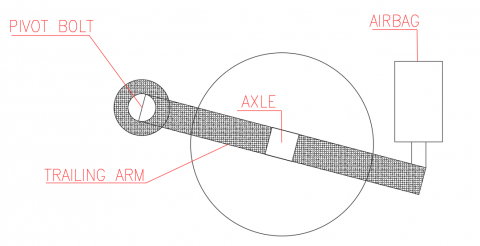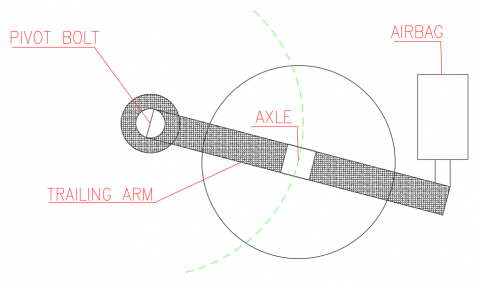Understanding Roll Steer

GIF ‘Tractor Bump Steer’. By Simiprof [CC BY-SA 3.0], from Wikimedia Commons
Advantia has previously written about how suspension performance can affect the outcome of a PBS assessment. In short, the three main factors are roll stiffness, roll centre height and roll steer coefficient.
Today we will be focusing on roll steer, sometimes referred to as bump steer, which is the tendency for axles to steer as the body rolls from side to side. While the concept applies to suspension, many of us have already experienced this phenomenon when using a skateboard. To turn on a skateboard, we lean in the direction we want to turn.
But what exactly is happening here? And why do some suspensions steer the opposite direction to the way the body rolls, while some steer in the same direction the body rolls?
The answer lies in geometry. Consider a very simple diagram of an airbag suspension (the concept also applies to mechanical suspension). We essentially have four components:
- the airbag
- the axle
- the suspension trailing arm
- the pivot bolt
 As the airbag compresses and expands, the axle moves up and down as expected. However, the axle actually rotates around the pivot bolt. This means that for the case shown below, not only does the axle move up if the airbag is compressed, but it also moves back.
As the airbag compresses and expands, the axle moves up and down as expected. However, the axle actually rotates around the pivot bolt. This means that for the case shown below, not only does the axle move up if the airbag is compressed, but it also moves back. Now imagine looking at the suspension not from the side, but from directly above.As the body rolls from side to side, you can’t see the up and down movement, but you can see instead just the forwards and backwards movement of the axle.Moreover, if the body rolls to one side, the airbags on one side of the vehicle are compressed and the airbags on the other side are extended. From the diagram above, you can see that if the airbag is compressed the axle moves forward, and if the airbag is extended the axle moves back. What happens when one side of your axle is pushed forwards and one side is pulled back towards you? (hint: think of a billy cart). This is roll steer.Now in the above examples, the axle’s neutral position was always below the pivot bolt. When the axle is above the pivot bolt then the opposite occurs. As the airbag is compressed, when looking from above, the axle moves forwards.In general terms, overslung suspension tend to have the pivot bolt above the axle, while underslung suspensions tend to have it below.This means that for overslung suspension, as the body rolls, the suspension will typically steer in the direction the body is rolling, like the front axle of a skateboard. For underslung suspension, as the body rolls, the suspension will instead typically steer in the opposite direction to the way the body is rolling, like the rear axle of a skateboard.
Now imagine looking at the suspension not from the side, but from directly above.As the body rolls from side to side, you can’t see the up and down movement, but you can see instead just the forwards and backwards movement of the axle.Moreover, if the body rolls to one side, the airbags on one side of the vehicle are compressed and the airbags on the other side are extended. From the diagram above, you can see that if the airbag is compressed the axle moves forward, and if the airbag is extended the axle moves back. What happens when one side of your axle is pushed forwards and one side is pulled back towards you? (hint: think of a billy cart). This is roll steer.Now in the above examples, the axle’s neutral position was always below the pivot bolt. When the axle is above the pivot bolt then the opposite occurs. As the airbag is compressed, when looking from above, the axle moves forwards.In general terms, overslung suspension tend to have the pivot bolt above the axle, while underslung suspensions tend to have it below.This means that for overslung suspension, as the body rolls, the suspension will typically steer in the direction the body is rolling, like the front axle of a skateboard. For underslung suspension, as the body rolls, the suspension will instead typically steer in the opposite direction to the way the body is rolling, like the rear axle of a skateboard.
The roll steer coefficient is a measure of to what degree this occurs. Note that the degree to which it occurs can also be affected by not only the geometry but also compliance in the suspension components.
What about mechanical suspension?
In the case of mechanical suspension, the same concepts apply. The main difference is that instead of thinking about the position of the pivot bolt, consider the point about which the radius rod pivots relative to its axle connection.
What does this mean for vehicle dynamics?
If you are only concerned about roll steer, then underslung suspensions will generally perform better due to the suspension steering into the corner. However, underslung suspensions also will generally have a lower roll centre, which has adverse implications for roll stability. Like many facets of component design, there is a balance that must be struck when considering the interplay of different parameters and their effects on heavy vehicle performance.
Get more like this in your inbox
Subscribe to our Newsletter and never miss a post.